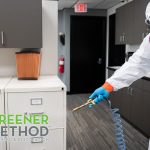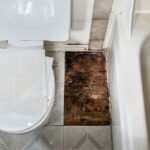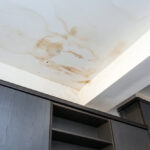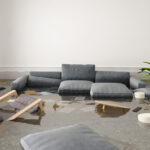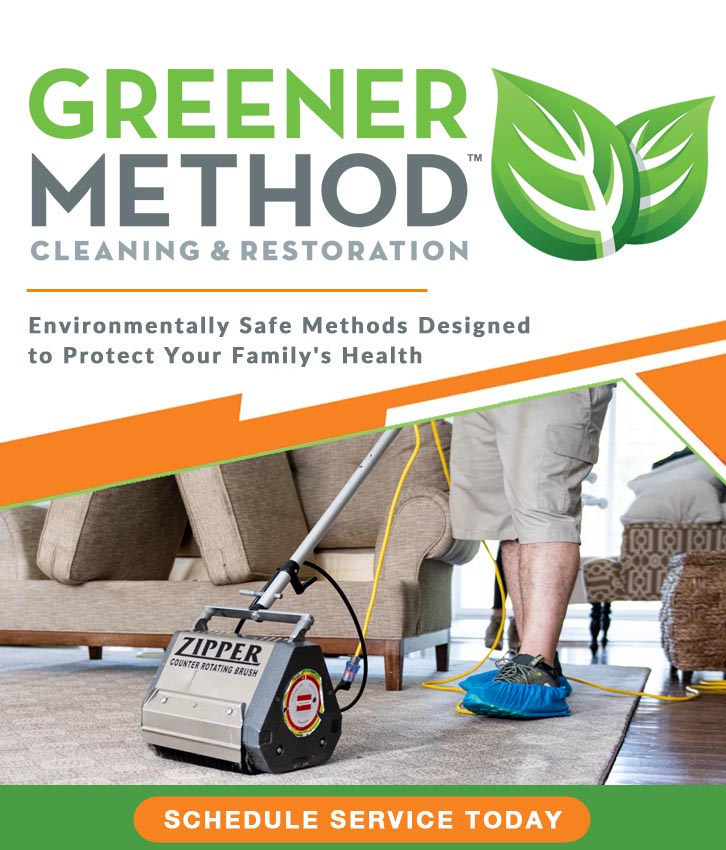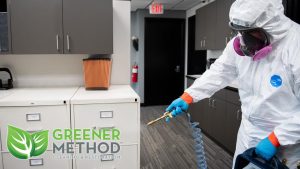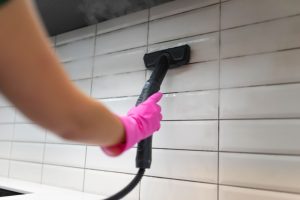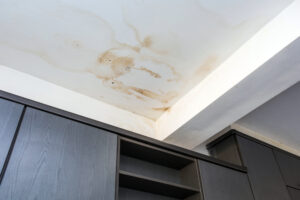Did you know a typical household water leak can waste almost 10,000 gallons of water yearly? This not only harms the environment but also damages your home’s structure and encourages mold growth. Taking quick action is key to fixing water damage and preventing mold. Knowing the right steps can help avoid minor issues turning into big repair costs, keeping your home safe after flooding.
Key Takeaways
- Quick action is essential for effective water leak cleanup.
- Safety should be prioritized, especially around electrical appliances.
- Small-scale leaks may be managed by homeowners, but larger exposures require professional mitigation.
- Use fans, dehumidifiers, and desiccants for drying affected areas.
- Professional services use advanced tools for thorough drying and to prevent secondary damage.
Initial Safety Measures
When dealing with a water leak, safety comes first. Make sure electrical appliances are safe as you start cleaning up. Right after you notice a leak, turn off the water supply valve. This helps stop more water damage.
Wilkinson from Benjamin Franklin Plumbing says to turn off your home’s power and gas if water reaches outlets or electrical systems. This prevents dangerous situations. Always wear gloves, goggles, masks, and strong shoes while cleaning to stay safe from injuries and illnesses.
The CDC suggests calling an electrician if there’s a lot of standing water to avoid electrical shock. By following these steps, you can reduce the risks from water damage.
Identifying the Source of the Leak
Finding where a water leak comes from is key to fixing it and stopping more damage. Homeowners should start by looking for signs like moisture or mold on walls and ceilings. They should also watch for changes in water pressure.
There are many ways to find water leaks. Homeowners can check the water meter for any movement when no water is being used. Looking at utility bills for unusually high water usage can also show hidden leaks. Using food coloring to test for toilet leaks is a simple and effective method.
Some physical signs can tell homeowners there’s a leak. Seeing water pooling, hearing dripping sounds, or seeing rust around pipes are all signs of water damage. These signs can help find where the leak is.
- Moisture or mold on walls and ceilings
- Changes in water pressure
- Movement in the water meter without usage
- Abnormally high utility bills
- Food coloring test for toilet leaks
- Pooling water, dripping sounds, and rust around pipes
If leaks are hard to find, it might be best to call professional plumbers. They have the skills to find and fix the problem. This helps prevent mold and reduces damage to the structure.
Removing Standing Water
Quickly removing standing water is key to handling water damage and stopping further problems. Use a wet-dry vacuum for effective flood water extraction. These vacuums are great for smaller water amounts and are handy for homeowners. If you don’t have a wet-dry vacuum, absorbent towels can soak up water, but it takes more effort.
For big floods, move your belongings to a dry spot to clean up. In these cases, getting rid of the water fast is crucial to save your home’s materials. Companies like Wilkinson and Crow, experts in plumbing and water damage repair, highlight the urgency of acting quickly.
A sump pump can quickly remove a lot of water, especially in basements or lower floors. The quicker you clear the water, the less chance it has to spread and cause more damage. Plus, acting fast can stop mold from growing, which can happen in 24-48 hours.
Always put safety first when dealing with flood water. Wear protective gear and make sure electrical systems are off to stay safe. By starting to remove the water right away, you can lessen damage and protect your home.
Drying Out the Affected Area
After removing standing water, it’s key to dry out the area to stop more damage and stop mold. Here are the main steps to follow:
- Open windows, doors, and cabinets to let air in. This helps get rid of dampness.
- Keep fans and dehumidifiers running for a few days. These tools help dry out the area well.
- Focus on drying surfaces that soak up water easily, like drywall and baseboards. This helps stop mold and protects the structure.
Using these steps can make drying out flooded areas more effective. Keeping air moving is crucial for drying and keeping your home safe and healthy. Restoration Local suggests these methods for complete moisture removal and lasting results.
Cleaning and Disinfecting Surfaces
After drying the affected area, the next step is to clean and disinfect surfaces touched by water. This is key to reduce contamination risks.
To clean and disinfect, mix hot water, soap, and disinfectant. A good mix is 1 ounce of bleach per 4 gallons of water. Use this to clean floors, walls, and items hit by the water leak. This makes sure everything is properly disinfecting after flooding.
When cleaning, always wear protective gear. An N95 respirator is great for protecting against mold, which is key in mold and mildew prevention.
After cleaning and disinfecting, let the treated areas sit for at least 10 hours. This time lets all substances dry out fully. It also makes sure the disinfection works well.
Assessing Structural Damage
After cleaning and disinfecting, it’s key to check the home’s structure for damage. Water can harm many parts of the house, so a detailed check is needed.
Start with materials like sheetrock and wood that soak up water easily. Look for signs of damage, like warping or weakening. These signs mean you might need a closer look at the water damage.
If you find a lot of damage, get help from experts. They can tell if you need to fix or replace damaged parts. They’ll look at the full damage and help fix it safely and right.
By acting fast, homeowners can lessen risks and keep their homes strong. This helps protect their investment.
Preparing for a Professional Remediation Service
When you face a lot of water damage, it’s key to get professional help for a full and safe fix. Before you call a water damage service, take lots of photos of the damage. This is crucial for insurance claims and for experts to give accurate advice.
A top water damage service can use special skills and methods to stop more damage, like mold. They know how to clean up after floods and fix water damage well. This means your home will be like new again, fast and right.
Before you call anyone, look for trusted plumbing and water damage experts.
Also, getting rid of mold is a big part of fixing water damage. Mold is bad for your health, so it’s important to stop it from growing. With professional flood cleanup services, you get everything taken care of, from checking things out to fixing the damage. This gives you peace of mind.
Conclusion
Fixing water damage takes careful steps to keep your home safe and dry. First, find and fix the leak quickly to stop more problems. Then, dry and clean the area well, and check for any damage to the structure.
It’s not just about fixing the leak; it’s also about preventing new ones. Keep your plumbing in good shape and use smart water sensors. These steps help lower the chance of leaks and damage in the future.
Getting help quickly and from experts is crucial when dealing with water damage. They make sure everything is fixed right, keeping your home and family safe. In short, acting fast and maintaining your home can help avoid future leaks and damage.






